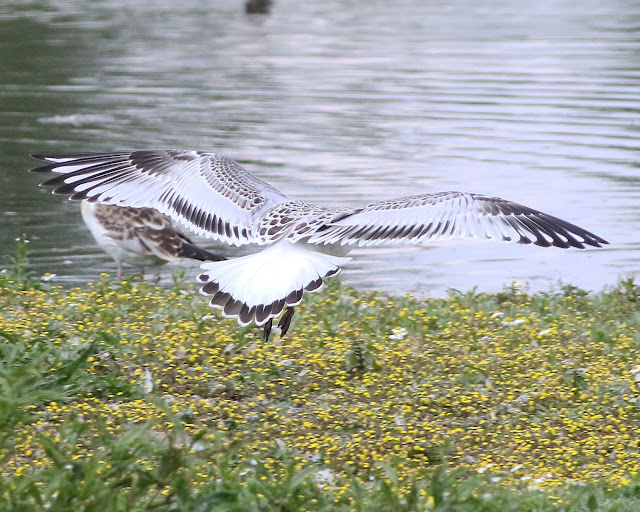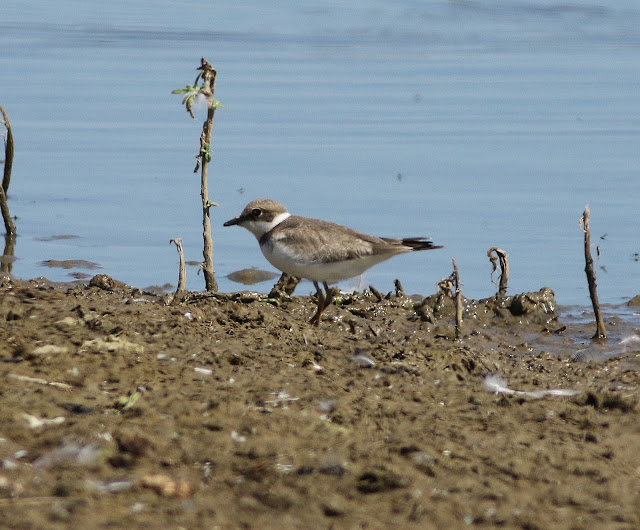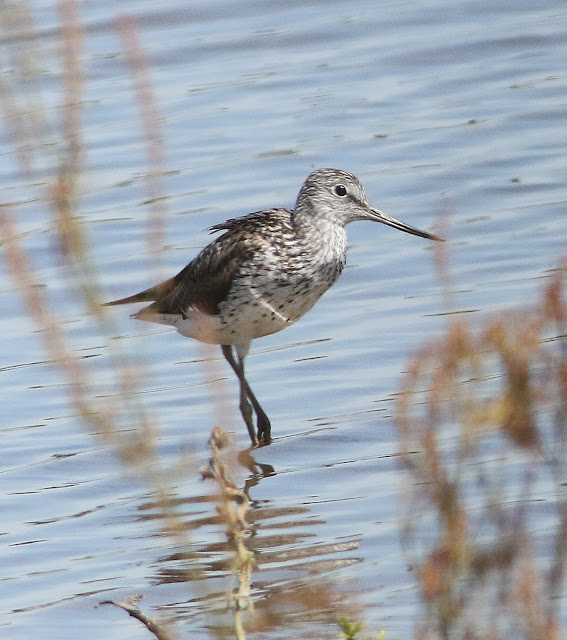21st July 2016
A nice sunny afternoon to pop down to Rye Meads and see what was around. The Kingfishers have just fledged and are showing well in front of the Kingfisher Hide, so the Draper Hide should be nice and quiet. The resident Little Grebes were just outside the window as usual and bringing food to their two small chicks.
The other key species, the Green Sandpipers, were also much in evidence with seven individuals on show, many sporting colour rings from previous visits to Rye Meads or Lemsford Springs.
Tufted Ducks were also diving right in front of the hide, having parked their brood on one of the nearby islands, and Common Terns were bringing in food for their well-grown chicks.
There are three Garganey at Rye Meads at the present time although I could only find two and only one of them was active albeit as far away from the hide as possible. The size comparison with the Gadwall in the foreground is worth noting.
But today's star was the juvenile Mediterranean Gull out on the islands whose well-marked plumage and larger size stood out from the Black-headed Gulls.
It even went for a short flight to show off its distinctive wing pattern with the pale grey bars.
Fantastic!! I normally have to go to Southend Pier to photograph them this close.
Thursday 28 July 2016
Saturday 23 July 2016
A Couple of Hours in the Mere Hide at Lakenheath Fen
20th July 2016
The Mere Hide at Lakenheath Fen was opened on the 31st January 2014 and there have been some good sightings from this hide including Bitterns and Kingfishers. However, for me it is a different story. Up until now it has been one of those hides that I can't bring myself to walk past just in case I miss something, but the reality is that I have never seen anything of note.
However, the reason for visiting today was to escape the searing heat and to have a well-earned rest, so anything that popped up would be a bonus. Very quiet on the bird front, but there was a lot of Odonata activity across the floating algae in front of the hide. This type of habitat is loved by damselflies such as the Blue-tailed Damselfly, watched over by a couple of Common Blue Damselflies on their flag-pole.
Red-eyed Damselflies were both common and busy mating, as was this female Emperor laying her eggs on vegetation just under the waterline.
However, back to the birds and the only action so far was this adult Sedge Warbler collecting food for its brood nearby, and obviously damselflies are top of the menu.
But then an unexpected visitor, a fly-by Bittern flying from its nest to catch fish for its young. Not very good I'm afraid, as the trees in the background made focusing difficult, but a record of the day nevertheless.
But then to finish off a magical day I heard the call of a Kingfisher getting louder and louder, but still not visible. The reason for this was that it was sitting on the roof of the hide!! So there we were, wondering what was going to happen next. Eventually it dropped into the water just a yard in front of the hide and flew with a fish to one of the perches provided and sat there for a few minutes allowing some great opportunities.
After you have eaten your fish there is time for a bit of cleaning and time to address that itch.
Then time for another fishing sortie, again starting from the top of the hide, dropping into the water and emerging with......A PIKE!!!!
So this top predator doesn't always get its own way.
Well, at least this week, the Mere Hide came good and I will always give it a few minutes whenever I am passing.
The Mere Hide at Lakenheath Fen was opened on the 31st January 2014 and there have been some good sightings from this hide including Bitterns and Kingfishers. However, for me it is a different story. Up until now it has been one of those hides that I can't bring myself to walk past just in case I miss something, but the reality is that I have never seen anything of note.
However, the reason for visiting today was to escape the searing heat and to have a well-earned rest, so anything that popped up would be a bonus. Very quiet on the bird front, but there was a lot of Odonata activity across the floating algae in front of the hide. This type of habitat is loved by damselflies such as the Blue-tailed Damselfly, watched over by a couple of Common Blue Damselflies on their flag-pole.
Red-eyed Damselflies were both common and busy mating, as was this female Emperor laying her eggs on vegetation just under the waterline.
However, back to the birds and the only action so far was this adult Sedge Warbler collecting food for its brood nearby, and obviously damselflies are top of the menu.
But then an unexpected visitor, a fly-by Bittern flying from its nest to catch fish for its young. Not very good I'm afraid, as the trees in the background made focusing difficult, but a record of the day nevertheless.
But then to finish off a magical day I heard the call of a Kingfisher getting louder and louder, but still not visible. The reason for this was that it was sitting on the roof of the hide!! So there we were, wondering what was going to happen next. Eventually it dropped into the water just a yard in front of the hide and flew with a fish to one of the perches provided and sat there for a few minutes allowing some great opportunities.
After you have eaten your fish there is time for a bit of cleaning and time to address that itch.
Then time for another fishing sortie, again starting from the top of the hide, dropping into the water and emerging with......A PIKE!!!!
So this top predator doesn't always get its own way.
Well, at least this week, the Mere Hide came good and I will always give it a few minutes whenever I am passing.
Tuesday 19 July 2016
Waders and Wagtails at Abberton Reservoir
18th July 2016
The first trickle of migrants are arriving so time for my first "Autumn" visit to Abberton. I arrived at a baking hot Layer Breton causeway and rather surprisingly was the only birder there, so after a spot of breakfast started the scan the banks. The first surprise was an eclipse/young male Mandarin which in my experience is a rare bird at Abberton.
As expected Yellow Wagtails were collecting food for their young in the nests in the adjacent fields and apparently Common Blue Damselfly was high on the menu.
Initially, apart from a lone Lapwing, the causeway seemed to be devoid of waders with none of the hoped for Ruff, but I did eventually manage to find a Common Sandpiper skulking behind some vegetation. There are normally quite flighty but this one was a little more accommodating.
Now on to the reserve and in to the relative cool of one of the hides. Luckily the water levels are very high and so the muddy margins are only 10 yards away from the hide, so I wonder what will turn up. The first bird to appear was a rather smart adult Goldfinch feeding on the many seeds.
Little Egrets are also quite happy to strut up and down right outside the hide whilst fishing on the massive shoals of fry present in the shallows, allowing some action shots to be taken.
Unexpected visitors today were three Stock Doves which rather than just coming down for a drink as usual were either loafing around on the beach or occasionally looking for seeds. Either way it was nice to get some shots of this totally under-rated bird with its subtle pastel colouration and iridescent green neck patch.
I then managed to pick out a juvenile Ringed Plover which was hidden on the mud amongst some waterside vegetation. It hardly moved all the time I was there so photo opportunities were limited
Then the moment I was hoping for. I could hear the shrill peep-peep-peep of a Greenshank and saw two birds flying left past the hide. Luckily at that point they turned towards the shore and landed on a spit some 40 yards away. A little bit further than I would have liked, but still managed to grab a few shots as they moved through the vegetation before flying off.
Well, if that was the first day of Autumn, BRING IT ON!!!!
The first trickle of migrants are arriving so time for my first "Autumn" visit to Abberton. I arrived at a baking hot Layer Breton causeway and rather surprisingly was the only birder there, so after a spot of breakfast started the scan the banks. The first surprise was an eclipse/young male Mandarin which in my experience is a rare bird at Abberton.
As expected Yellow Wagtails were collecting food for their young in the nests in the adjacent fields and apparently Common Blue Damselfly was high on the menu.
Initially, apart from a lone Lapwing, the causeway seemed to be devoid of waders with none of the hoped for Ruff, but I did eventually manage to find a Common Sandpiper skulking behind some vegetation. There are normally quite flighty but this one was a little more accommodating.
Now on to the reserve and in to the relative cool of one of the hides. Luckily the water levels are very high and so the muddy margins are only 10 yards away from the hide, so I wonder what will turn up. The first bird to appear was a rather smart adult Goldfinch feeding on the many seeds.
Little Egrets are also quite happy to strut up and down right outside the hide whilst fishing on the massive shoals of fry present in the shallows, allowing some action shots to be taken.
Unexpected visitors today were three Stock Doves which rather than just coming down for a drink as usual were either loafing around on the beach or occasionally looking for seeds. Either way it was nice to get some shots of this totally under-rated bird with its subtle pastel colouration and iridescent green neck patch.
I then managed to pick out a juvenile Ringed Plover which was hidden on the mud amongst some waterside vegetation. It hardly moved all the time I was there so photo opportunities were limited
Then the moment I was hoping for. I could hear the shrill peep-peep-peep of a Greenshank and saw two birds flying left past the hide. Luckily at that point they turned towards the shore and landed on a spit some 40 yards away. A little bit further than I would have liked, but still managed to grab a few shots as they moved through the vegetation before flying off.
Well, if that was the first day of Autumn, BRING IT ON!!!!
Subscribe to:
Posts (Atom)



















































